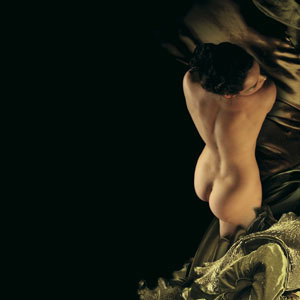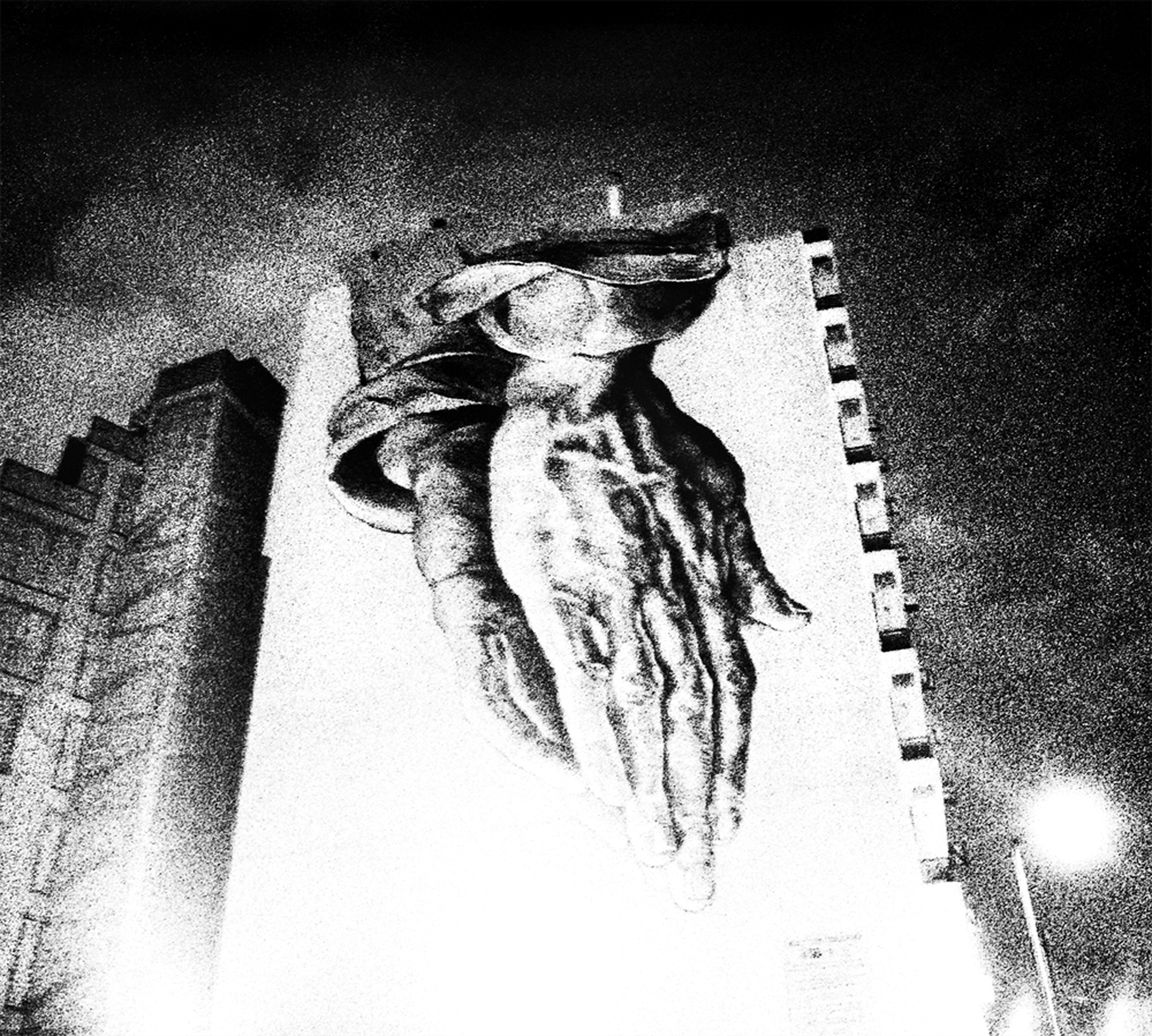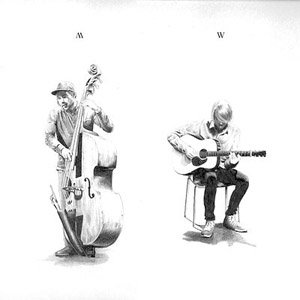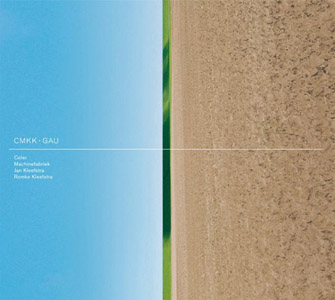- Administrator
- Albums and Singles

Artist: Z'EV
Title: A Handful Of Elements
Catalogue No: CSR182CD
Barcode: 5060174955457
Format: CD in jewelcase
Genre: Industrial / Ritual / Ambient
Shipping: Now
With “A Handful Of Elements” Z’EV returns to the “dense, carefully laid and deep drone works” [adnoiseam.net] of “Sum Things” (CSR101CD). However, for this release he has drawn deep from his 40 year old sonic archive (from live performances both instrumental and vocal to a range of soundscapes from around the world), producing soundtracks to accompany you to the other side of ambient, through the door between your eyes.
Tracks:1. Terra / 2. Aqua / 3. Aer / 4. Ignis / 5. Spiritus
Read More
- Administrator
- Albums and Singles
 Ben Chatwin is not one to shy away from ambitious concepts, having previously devoted albums to both the subconscious and the creation of the world.  Now, in collaboration with Fluid Radio's Dan Crossley, he tackles the more intimate subject of their shared alienation and misery in London.  Curiously, however, the music and packaging of Eaten Alive are much more elaborate than anything Chatwin has ever done before.  I had some difficulty reconciling myself with that, as something is definitely lost in Chatwin's transition from experimental guitarist to full-blown composer/urban historian/multimedia artist, but he certainly made a valiant and impassioned effort to do something truly unique and special this time around.
Ben Chatwin is not one to shy away from ambitious concepts, having previously devoted albums to both the subconscious and the creation of the world.  Now, in collaboration with Fluid Radio's Dan Crossley, he tackles the more intimate subject of their shared alienation and misery in London.  Curiously, however, the music and packaging of Eaten Alive are much more elaborate than anything Chatwin has ever done before.  I had some difficulty reconciling myself with that, as something is definitely lost in Chatwin's transition from experimental guitarist to full-blown composer/urban historian/multimedia artist, but he certainly made a valiant and impassioned effort to do something truly unique and special this time around.
Chatwin's music has always tended towards the cinematic, addressing compelling themes evocatively and with a thoughtful narrative and dynamic arc.  Eaten Alive certainly continues that tradition, but does so in a different way, resembling a soundtrack to a non-existent film rather a complete, fully-formed world of its own.  In a way, however, "the non-existent film" that Ben is soundtracking is actually the very real life of Crossley–specifically Dan's tales of addiction, crime, and homelessness in '80s London.  Crossley's contribution extended beyond just providing inspiration though, as the now sold-out limited edition further (and more concretely) illuminates his past with a booklet of his haunting, grainy photography from the period.  As a complete piece of art, that edition succeeds beautifully in many ways, but that success becomes quite a bit blurrier when the music is decontextualized and presented alone.
Another problem is that while Chatwin had no trouble brilliantly tackling the more abstract ideas of subconsciousness and dreaming with 2011's Descent into Delta, the seemingly more modest and tangible challenge of evoking a period from someone's life is one that does not suit his aesthetic nearly as well.  For an album that openly sets out to reflect the worst of human nature, Eaten Alive often feels like a very polished, muted, detached, and monochromatically melancholy affair.  Occasionally, Ben hits upon something inspired and apropos, like the roiling, buzzing, and snarling intro to "Little Pieces of Discarded Life," which sounds wonderfully like a broken televison in a ruined flat reluctantly coming into focus.  Many other times, however, Chatwin's music sounds positively baroque (such as in the crescendo of "The Secrets of the Sky").  There is nothing objectively wrong with that (it sounds like Talvihorros collaborating with John Carpenter on the credit music for a zombie film), but it feels like a bizarre choice given Eaten Alive's aim (but totally appropriate for its title, obviously).
Yet another problem is probably me and my preconceived idea of what I want a new Talvihorros album to sound like, as there are objectively a lot of very cool passages strewn thorough these 8 pieces, such as the heavy, buzzing outro of "Becoming Mechanical."  Also, there are a number of strong melodies and the whole thing forms a meticulously executed and coherent arc.  If I could just experience this album in a completely different context and forget that it was a Talvihorros album, I could probably enjoy it a lot more than I do, but I cannot.  I desperately want this album to be intimate and occasionally raw and violent (like life), but the complexly layered arrangments, deliberate pace, and homogenizing synth parts make me feel like I am listening to Mogwai covering a classic In The Nursery album or something.  I would have no (serious) problem with such a union occurring, but hearing Chatwin sound like that makes me wince a little.
Of course, all of my griping is rooted in the fact that I historically love Talvihorros, which has the unfortunate effect of saddling me with all kinds of critical baggage and expectation.  While I definitely prefer Ben's last two releases to this one, I am (grumblingly) still quite pleased that Eaten Alive exists: Chatwin and Crossley certainly cannot be faulted for lack of vision or effort and they break some interesting new ground in the realm of...what?  Experimental documentary (so experimental that there is not even a film)?  Abstract sonic biography?  I have no idea.  In any case, this was an excellent idea for a project that probably thoroughly delighted the 200 people who got the complete experience.  As pure music alone, it does not necessarily work for me, but I hope Ben is not dissuaded from taking similarly bold chances in the future.
 
 
Read More
- Administrator
- Albums and Singles

Robert Millis is not exactly a household name, but anyone with a healthy curiosity for the musical fringes has probably unknowingly encountered at least one thing that he has been involved in over his lengthy career.  Recently, he has been most prolific as a filmmaker for Sublime Frequencies, but he has also curated or worked on some of the most interesting compilations to emerge over the last several years (Dust-to Digital's Victrola Favorites, for example).  He is also one of the founding members of Climax Golden Twins as well as an occasional solo artist, as he is here.  Appropriately, Relief seamlessly blends together many of Millis' esoteric pursuits, but it does so in a more understated, raga-drone way than I expected.
Curiously, this album is described by the label as "more Nurse With Wound than The Caretaker," invoking two artists that have little overt resemblance to what it is that Millis does.  There are certainly fleeting elements of both (brief snatches of surrealist whimsy and brooding orchestral passages, respectively), but Relief does not particularly warrant comparisons to any auteurs, resembling a fairly straightforward drone album assembled from very unstraightforward materials.  It is certainly a very good drone album, but its distinctive traits are generally quite subtle, abstract, or ephemeral in nature.
The most uniquely Millis-ian touch to be found is that many of the droning, repeating motifs sound like they could be blurred, stretched, and pitch-shifted samples from some long-lost Molam or Luk Thung obscurities or one of Robert's recently anthologized 78s from Korea or Burma.  Almost all of these five pieces betray those origins or inspirations in one way or another, but they all offer their own twists to the formula as well.  The most successful of the lot is probably the opening "Secret Sentence," which buffers its hazy burbling loop with a kitschy old dialogue snippet and an unexpected plunge into dark orchestral tumult.  The closing title piece is similarly successful, yet radically different in structure, spending most of its 16 minutes engaging in gently quavering, one-chord drone before slowly giving way to what sounds like an especially insistent dripping.
The other aspect to Relief that stands-out is a particularly weird, muted strain of unpredictability.  The aforementioned "Relief," for example, continues beyond its logical conclusion point into a throbbing, hallucinatory coda mingled with pastoral piano noodling.  Also, the aberrant "Second Lord of the Auspicious Conjunction" is wrong-footing in almost every respect, sounding like snatches of a classical album being heard through some kind of disquieting and dissonant supernatural fog before being violently interrupted by vinyl crackle and returning as a new piece.  The overall feeling is like having a nightmare about an indecisive ghost who cannot make it through an entire song without restlessly flipping the record.  Which, of course, is fairly novel and enjoyable (for me, anyway).
Ultimately, Relief feels like a somewhat slight album, but endearingly and willfully so.  Part of me definitely wishes Millis had not devoted so much of its running time to simple droning loops and repetition (and amateurish one-finger piano interludes), yet Millis' patience, confidence, and odd sensibility give the album a woozy, sublime, and unhurried charm.  In that deeper and somewhat nebulous sense, this effort is actually quite unique: Millis is the rare artist who egolessly lets sounds flow (rather than conspicuously exerting his will) and hints at depth and exoticism (rather than making things explicit).  While Relief sounds contemporary, it feels like it comes from a very different aesthetic place than the here and now.  Which, I suppose, makes it something of a minor triumph.
 
 
Read More
- Administrator
- Albums and Singles

Somewhere in the rainy, misty forests of the Pacific Northwest of America, three ladies have the unlikely task of sewing together the packaging for a new album by Zoviet France.
The Tables Are Turning, released by Soleilmoon Recordings on November 18, consists of recordings from the soundtrack to the contemporary dance production, "Designer Body." The dance, premiered by British dance company, Ballet Lorent, in 2008, explores the transformational relationship between humans and the clothing they wear.
Seven dancers, performing on continuously rotating plinths, slowly remove layers of their costumes, revealing the sensuous nude bodies beneath. The music accompanying the dancers is by turns dense and moody, then lyrical and soaring, underlining the mounting vulnerability of the dancers as they undress.
Liv Lorent, Ballet Lorent's artistic director and choreographer, spoke with Kelly Apter, writer for The List, saying "At the beginning, the body is the most designed it can be. They're wearing hats, coats, heavy costumes and make-up – all the man-made and artificial things we do to disguise ourselves everyday. Then, over 18 minutes, we take it all away. And because there are several layers, there's a real sense of metamorphosis."
The members of Zoviet France, who prefer to remain anonymous, write “We've known Liv Lorent for a long time. When she started to conceive 'Designer Body,' which she wanted to be a hybrid of contemporary dance and performance art, she decided that an unconventional performance needed an unconventional soundtrack. The composition of the soundtrack and the choreography evolved alongside each other so it became a dialogue between Liv and ourselves. The main inspiration that we took from the production's concept was rotation; throughout the one hour performance, the dancers are located on turntables that turn continuously, at varying speeds and changing direction. We mirrored this in much of the soundtrack, with circular and rotating sounds."
More information cam be found here.
Read More
- Administrator
- Albums and Singles

In 2006, Hisham Mayet returned to West Africa to continue his search for an unknown musician he had heard six months earlier on the radio in a Morocco hotel room. Knowing only that it was Sahrawi music — music of the south — he headed down through the vast and remote desert landscape of the Western Sahara and Mauritania in hopes of finding someone who could identify these revelatory recordings.
That artist was Group Doueh. But he also found much, much more as he wandered from Laâyoune, Western Sahara, to Mauritania's capital city of Nouakchott: From intimate, sinuous home recordings by Group Marwani, to a sublimely devastating track by the enigmatic Abdul Rahman Al-Gheid, to the inimitable tidinit artistry of Sadoum Ouled Aida, the performers on this album exemplify the haunting and intoxicating qualities of Sahrawi music.
Featuring Mayet's first recordings of the electrifying Group Doueh, as well as dizzying field recordings from Nouakchott's Marché Capitale — where relentless traffic noise swirls together with fragments of melody from countless cassette vendors’ PA speakers— Hassānīya Music from the Western Sahara and Mauritania is the evocative soundtrack to a chimerical journey that is also documented visually in Sublime Frequencies’ breathtaking film Palace of the Winds. It not only traces Mayet's own passage through these barren and beautiful lands, but also charts the evolution of Sahrawi music from sung poetry accompanied by traditional acoustic instruments to electrifying modern grooves drenched in reverb and phase effects.
Limited edition pressing with Stoughton tip-on full color gatefold jacket.
More information is available here.
Read More
- Administrator
- Albums and Singles

In 2005, Sublime Frequencies released Choubi Choubi: Folk and Pop Sounds from Iraq, and in the ensuing years it has become one of the most beloved and venerable titles in their catalog. Now, almost nine years later, this highly anticipated second volume is finally here. Compiler and producer Mark Gergis has once again put forth a revelatory and poignant collection of Iraq's national folk music.
The musical style most prominently focused on in this volume is the infamous Iraqi choubi, (pronounced choe-bee), with its distinct driving rhythm that can feature fiddles, double-reed instruments, bass, keyboards and oud over its signature beat. Choubi is Iraq's version of the regionally popular dabke, another celebratory Levantine folkloric style of rhythm and line dance. What really defines the Iraqi choubi sound are the crisp, rapid-fire machine-gun style percussive rhythms set atop the main beat. To the uninitiated, they sound almost electronic. Sometimes they are, but more often this is the work of the khishba – a unique hand-drum of nomadic origin (aka the zanbour – Arabic for wasp), which appears across the board in many styles of Iraqi music today, with extensions of it also heard in Syrian and Kuwaiti music. Among other styles featured in this volume are Iraq's legendary brand of mawal – an ornamental vocal improvisation that sets the tone of a song, regardless of the style, and the outstanding Iraqi hecha, with its lumbering and determined rhythm pulsing beneath sad, antagonized vocals.
The tracks on this collection were produced during the Saddam era – between the 1980s and early-2000s. An important goal within the Iraqi Baathist agenda was to promote its brand of secularism, which saw the establishment of cultural centres, and a fostering of the arts. Music was more encouraged, albeit more institutionalized than ever – particularly folkloric and heritage music such as choubi. In an Iraqi army comprised of seven divisions, Saddam referred to singers as the eighth. Still, unless a rare level of stardom has been achieved, being a singer or musician isn’t usually encouraged or viewed as a respectable lifestyle in much of the Arab world. It’s often those deemed social outsiders that tend to find their niche in music – particularly the "party music" heard on this collection. Among them are the Rom Gypsy Iraqis (known as Kawliya in Arabic). A number of female singers wear masks and adopt pseudonyms to protect their identities, as some are runaways or prostitutes making ends meet in the seedy nightclub scene. Occasionally, they end up with successful recording careers.
Sajida Obeid, who has appeared on both volumes of Choubi Choubi! is an example of a talented Kawliya singer from the nightclub scene of the 1980s who rose to choubi infamy in Baghdad. Choubi inevitably invokes tawdry connotations within Iraqi society (cheap nightclubs for the lower classes, outcast gypsies and singing prostitutes), but in fact, many calibers of Iraqi singers and ensembles have recorded and performed the music.
Unofficially, choubi can be called the national dance of Iraq. Though some may deny this claim (mostly due to its reputation and stigma), at most Iraqi weddings you'll find people from all walks flaunting their best choubi moves. Iraqi music has always had a way of transcending religious groups and ethnicity, collectively shared between Arabs, Kurds, Assyrians and myriad other Iraqi minorities. In 2013 sadly, this diversity and unity within Iraq is increasingly fragmented, but traditions continue throughout the internationally displaced diaspora.
(Limited edition 2-LP set in heavy gatefold jacket with beautiful artwork and liner notes by Mark Gergis)
Read More
- Administrator
- Albums and Singles
 Two forces define Jason Molina's entire career: work—he was almost obsessively dedicated to his craft—and his band. In 2003 he brought these forces to Steve Albini's Electrical Audio in Chicago and, with nine other musicians, caught lightning in a bottle. Up to that point Molina had made a case for his being a great songwriter, but on Magnolia Electric Co. he became a great bandleader. Those nine other musicians share the spotlight with him on these eight songs, and rightfully so. They're an integral reason Magnolia ended up one of the best rock 'n' roll records ever recorded.
Two forces define Jason Molina's entire career: work—he was almost obsessively dedicated to his craft—and his band. In 2003 he brought these forces to Steve Albini's Electrical Audio in Chicago and, with nine other musicians, caught lightning in a bottle. Up to that point Molina had made a case for his being a great songwriter, but on Magnolia Electric Co. he became a great bandleader. Those nine other musicians share the spotlight with him on these eight songs, and rightfully so. They're an integral reason Magnolia ended up one of the best rock 'n' roll records ever recorded.
From his debut 7" in 1996 until 2003 Jason Molina's band changed with virtually every new release. He played and recorded with Arab Strap, Richard Youngs, Geof Comings, Jonathan Cargill, Mike Mogis, Edith Frost, Dave Fischoff, Alasdair Roberts, and many others; too numerous to count here.
These are the people, as much as Molina, who made Songs: Ohia what it was. Jason knew this and admitted it in various interviews. With Magnolia Electric Co. he acknowledged it, and practically handed the album over this friends and fellow musicians.
The big themes come first: transformation, doubt, partnership, work, and fate—Jason's magical lyricism rides on top of these concerns. He communes with spectral guides and ghostly conspirators; presents deserts, flowers, and ghost towns as trail cairns for lovesick wanderers; and draws Comiskey Park together with the ancient light of distant stars. He writes about broad spaces, thoughts, and inner experiences, and then brings them to life with these details. Until, in the album's penultimate moment, as "John Henry Split My Heart" nearly flies off the rails, Molina reels the band's energy in for just a few lines. In the equivalent of a rock 'n' roll soliloquy, he sings, "Boy what you gonna do with your heart in two?" He replies, "Only if it's good enough, half I'm gonna use to pay this band. Half I'm saving, 'cause I'm gonna owe 'em."
Jason Molina was undoubtedly a great songwriter. As his solo albums, numerous solo bootlegs, and the newly reissued Magnolia demos show, he could carry a song all on his own, sometimes just on the strength of his voice. For the 2003 recording session, he had worked out all the lyrics in advance, knew the basic chords and shapes the songs would take, and maybe even knew how everything would fit together. A few of those songs had been tested on the road the year before too, with a band in tow. But incredibly several of the album's most memorable melodies aren't there in the demos, or even in the pre-album live versions.
Jim Grabowski's floating Wurlitzer accompaniment on "Just Be Simple," Dan Macadam's dancing violin on "The Old Black Hen," Dan Sullivan's angular guitar playing, even Mike Brenner's lap steel lead on "Farewell Transmission"—they were all almost unbelievably invented by the musicians, in the studio, on the spot, without the benefit of knowing the songs well in advance, using overdubs to fix mistakes, or having rehearsal time. Jason wasn't kidding about owing them.
That spontaneity gives the music its loose, anything-could-happen feel; the sort of rambling, improvisational quality that causes listeners to draw connections to country and gospel music when they hear the album. Molina's ideas, what he brought to the table as a writer, pull the record in the opposite direction. He's the one that makes the music sound tightly wound; it's his ability as a leader that makes it all sound inevitable.
And that says nothing of the incredible rhythm section Jason had in Jeff Panall and Rob Sullivan, or of Jennie Benford's haunting harmonies, or of spectacular start on side B, where he gives up the mic to Lawrence Peters and Scout Niblett on "The Old Black Hen" and "Peoria Lunch Box Blues." Jason disappears into both of those songs, making it hard to say where he even is in the mix. They're his songs sure enough, but it's the team that's making them sing. Other bands have worked in a similar way, but few have left so much to the fates and come out the other end with an album that sounds as confident and energetic as Magnolia Electric Co.
To the inclusion of the reissued demos, this 10th anniversary edition adds two studio recordings; one brand new, one difficult to find until now. Acoustic versions for both songs were featured on the demo disc in the album's limited first edition, but the big draw for anyone who has those already are these studio additions. "The Big Game Is Every Night" was previously available on the Japanese edition of the album, but thank God it's finally available domestically because it's stunning, and almost perfectly embodies the entire album. Above a dark, swirling mass of droning strings, Molina delivers urgent line after urgent line of historical images, references, and self-accusations that only he could have imagined. Cutting it from the record must have been painful, but it's such a massive black hole of a tune that it would have swallowed all the light around it. It makes perfect sense on it's own, after the album has ended, or on the 10" that comes with the vinyl version.
"Whip-Poor-Will," on the other hand, falls a bit flat. The demo version is great, and the studio treatment it received on Josephine is heart-rending, but the Magnolia version simply sounds incomplete, as if Jason and Jennie Benford had a good idea, but couldn't find a way to make it work with the time they had.
Hearing it reinforces just how perfect everything else is. Unbelievable is a good word for it, and maybe lucky too. But good bands make their own luck, and this band was as good as they come. As good as the ones Dylan had in '64 and '65, as rough and powerful as Crazy Horse, at times as heavy and as energetic as Hendrix, Redding, and Mitchell. Together, these ten musicians could go toe to toe with anyone, and that's not hyperbole. Make no doubt about it, it's a fact; true like the solid earth. All you have to do to know it is listen.
 
samples:
 
Read More
- Administrator
- Albums and Singles
 In all the time that I have spent writing record reviews, I do not think I have ever been able to say that a band has burst onto the scene without the use of ironic quotation marks, but I think this French trio finally warrants it: three weeks ago I had never heard of Oiseux-Tempête and today I am saying that they have made the single most exciting and bad-ass post-rock album since...uh...well...I cannot even remember the last time there was a great post-rock album. In any case, this epic favorably calls to mind all the ambition, urgency, and cinematic scope that characterized Godspeed! You Black Emperor's debut.
In all the time that I have spent writing record reviews, I do not think I have ever been able to say that a band has burst onto the scene without the use of ironic quotation marks, but I think this French trio finally warrants it: three weeks ago I had never heard of Oiseux-Tempête and today I am saying that they have made the single most exciting and bad-ass post-rock album since...uh...well...I cannot even remember the last time there was a great post-rock album. In any case, this epic favorably calls to mind all the ambition, urgency, and cinematic scope that characterized Godspeed! You Black Emperor's debut.
It is probably impossible to avoid discussing this album without repeatedly mentioning Godspeed, but the reason behind that is not due to any sort of slavish emulation or even a close resemblance between the two bands musically.  If anything, Oiseux-Tempête ("storm of birds") sound far more like a snarling, heavier twist on Explosions in the Sky mingled with more abstract drone- and field-recording-influenced soundscapes.  Godspeed's penchants for both strings and unrepentant degrees of bombast are (mostly) nowhere to be found here.  Nevertheless, the two bands share a lot of common ground in regard to inspiration, conceptual underpinning, and sense of purpose.  For example, this album's stated theme is nothing less than a "sonic odyssey" through "the qualms and queries of a sickly and dysfunctional Western society."  Also, Oiseux-Tempête is creatively interwined with filmmaker Stéphane C, who is documenting the "modern maelstrom" of Greece's gradual collapse.  This is a multi-disciplinary rock polemic, man.
Of course, none of those themes are explicitly conveyed through the actual music, though the album is peppered with various speech and news report recordings in case obsessive multilingual listeners want to appreciate it all on a much deeper and more profound level than I did.  For the rest of us, the band's passionate interest in the escalating unraveling of European civilization is important mostly because it inspired Oiseux-Tempête to create such a wonderful album.  Great art tends to happen when people feel very intensely about something, but that art is often even better when it is still abstract enough to resonate in a more universal way.  That is what is happening here–it is highly unlikely that I will become deeply immersed in the fate of Greece anytime soon, but this was certainly an inspiring, thought-stirring effort in a more general sense.
Musically, this sprawling double-album offers quite a bit to digest.  The band's raison d'être seems to be the soaring and atmospheric tremelo-picked guitar work of Frédéric Oberland, which favorably calls to mind both Tarantel and the aforementioned Explosions.  There is certainly no shortage of music in that vein and Oiseaux-Tempête are very good at it, skillfully avoiding any unnecessary clutter or go-nowhere improvisations and making the most out of their solid rhythm section (which unexpectedly features occasional Marissa Nadler/Beach House drummer Ben McConnell).  The best moments, however, are the ones where the trio twist that formula a bit by adding a bit more bite to the guitars than I expected, like the snarling, noisy stabs that enhance the opening "Opening Theme (Ablaze in the Distance)."  Album centerpiece "Ouroboros" is similarly inspired, opening with rattling strings and ending with a full-on guitar supernova.
Another thing I greatly appreciate is this band's talent for more abstract soundscapes built upon throbbing synths, shimmering processed guitars, and found sounds.  Oiseux-Tempête are rarely content with static drones or lush textures alone,  as pieces like "L'ile" are even more vibrant and dynamically compelling than the band's rock epics (they make up for lack of muscle in other ways). The trio also has a real gift for subtle psychedelia, which they display most beautifully in "Silencer," bolstering their clean, bittersweet arpeggios with woozy organ-like swells and an escalating crackle.  The opening of "Nuage Noir" is similarly beguiling, turning a somewhat banal spoken-word passage into something quite haunting with an eerily blurry bed of twinkling music-box-like tones.
If this album has a flaw, it is only that there is too much of it: I am rarely able to make it through its entirely in one sitting.  I have mixed feelings about that though.  If it were pared down to just a single LP, it would probably be a start-to-finish masterpiece.  However, it would also feel less like a bold statement of intent/uncompromising tour de force than it does now, which would be a bit of a shame.  Also, there is very little material present that could reasonably be identified as "filler": there are admittedly some very similar-sounding songs, but they all make a strong case for themselves on an individual basis.  And they combine for a very well-sequenced and powerful whole, even if it is a bit overwhelming.  This truly is a great album.  If anybody else has released a more impressive debut this year, I certainly have not heard it.
 
Read More
- Administrator
- Albums and Singles
 Neither Christian Winther nor Christian Meaas Svendsen are newcomers within the Norwegian improvised music scene, but this double disc set marks the first specifically solo releases from the two (albeit with a few collaborative moments as well). With Winther's guitar and Svensden's double bass making for the only instrumentation used, both produce amazing sounds and compositions out of such basic, traditional sources.
Neither Christian Winther nor Christian Meaas Svendsen are newcomers within the Norwegian improvised music scene, but this double disc set marks the first specifically solo releases from the two (albeit with a few collaborative moments as well). With Winther's guitar and Svensden's double bass making for the only instrumentation used, both produce amazing sounds and compositions out of such basic, traditional sources.
Winther's disc of solo acoustic guitar is home to the most conventional sounding moments to be had, and even that is a stretch at best."We Sleep" is made up of short, erratic string strums that become thicker and more intense with each passing second, and "How Rare to Bloom" even goes further and presents the guitar softer and more delicate sounding for its duration."Read" also follows a relatively conventional trajectory, even with a hint of dissonance surrounding it.
It is on songs like "Hair" that Winther coaxes the most unique sounds out of his instrument, and thus his playing makes the piece stand out.Aggressively plucked strings build into a rhythmic foundation while the metallic buzzing of the strings make for a pseudo melody, even though it bares almost no resemblance to a guitar."Backwards" is perhaps the most baffling to me, as it is a rhythmic piece structured from some sort of percussive sounds culled from a guitar that are almost impossible to place, as they do not sound like simply knocking on the instrument’s body. The result of this ambiguity is an inhuman, almost mechanical quality that definitely kept my ear.
Svendsen does similar things for his double bass on his disc, although here with even less touchstones to traditional sounding instrumentation.Only on "Prolonged Dots and Blunted Beams" does it sound like conventional plucked bass strings, but with a significant amount of string bending and stretching, it sounds quite unnatural."Der Runtergang" at first sounds like normal bowed bass strings, but as it slowly gets rawer and looser, the strings become more dissonant and harsh to almost have no resemblance at all to how it began.
He also works in his own unconventional methods of playing his instrument, such as the polyrhythmic "Hobby," which is all deep thuds and taut, percussive taps.Similarly, on "Double Rainbow," the bass is made to generate rhythms, but in this case it more closely resembles an ancient analog drum machine that is eventually balanced out with some obvious string plucks that are played so rapidly to resemble a sequenced synthesizer.
On a few a of the pieces the two collaborate together, with results that cover the gamut of what both artists do on their solo works."Ärt" is all rather delicate guitar and bass string plucks, which is surprisingly relaxing given the pieces that preceded it."Overslept" is the exact opposite, with both creating messy clattering noises with their instruments, both by physical impact and string playing, resulting in an intentionally messy free improvisation feel.
Even though they are two distinct solo albums with a small amount of overlap, both Winther and Svendsen take similar approaches to their own instruments and the unconventional misuse of them.For that reason they do feel intrinsically connected in some way, almost as if all of the solo pieces were a psychic collaboration unto themselves with or without the other’s awareness at the time.It makes perfect sense to present these together then, as each disc complements the other beautifully.
samples:
 
Read More
- Administrator
- Albums and Singles
 Recorded near the end of a European tour, Gau is the collaboration of Will Long (Celer), Rutger Zuydervelt (Machinefabrik), and brothers Jan and Romke Kleefstra. Although on their own these artists tend to work in quiet, sparse sounds, on this single improvised piece all open up quite a bit, bringing with them some forceful, aggressive moments as well as their traditionally restrained ones.
Recorded near the end of a European tour, Gau is the collaboration of Will Long (Celer), Rutger Zuydervelt (Machinefabrik), and brothers Jan and Romke Kleefstra. Although on their own these artists tend to work in quiet, sparse sounds, on this single improvised piece all open up quite a bit, bringing with them some forceful, aggressive moments as well as their traditionally restrained ones.
With its deep, rumbling opening—a field recording of thunder I assume—I at first expected more of the placid, introspective sounds that I have heard from Celer and Machinefabrik before, but once a bit of tortured guitar tone rose up sharply, my expectation changed.Even early in the piece, electronic static and crackles appear to form a dissonant counterpoint to the more musical nature of the guitar and an added synthetic tones.
The combination of the two approaches—musical and abstract—appears repeatedly throughout the nearly 48 minute duration of Gau.Complex loops of samples, laptop noise and found recordings trade off with quiet reverberating tones, as melodic electronics bounce off dissonant guitar noise and squall.It becomes forceful at times, but never aggressive or raw.
Jan Kleefstra's spoken word performance throughout is normally something I would find off-putting or distracting on an album such as this.Given that the rest of the piece is subtle electronics and occasionally boisterous drama, I initially worried that the presence of a human voice would be distracting and shift the focus too greatly, but that ends up not being the case at all.The vocals are performed in Frisian, an uncommon Germanic tongue, and placed tastefully low in the mix.They are not obscured by any means, but feel perfectly appropriate when they do appear.
I admit some trepidation in going into this album, because while I have the utmost appreciation for the work of both Celer and Machinefabrik, both of them tend to work in those delicate, sparse realms of sound that I have become a bit burnt out on as a genre.In this collaborative setting, with the two Kleefstras, the result is a bit more jagged and abrasive and therefore hit me as being fresh and different than what I expected.Gau does an exemplary job bouncing between the pensive and the ragged moments, and it is that unpredictability that is its greatest asset.
samples:
 
Read More
- Administrator
- Albums and Singles
My Cat Is An Alien have just finalized their most extreme work to date: 'PSYCHO-SYSTEM' is a 6 CD Box + Digital Download released by Elliptical Noise Records (Canada), representing the most advanced expression of their current creative method of composition through the brothers' brand new self-made strings and electronic instrumentation. An explicit warning reads that "prolonged exposure to sounds and high volume listening can cause episodes of psychotic break with reality, hallucinations, schizophrenia, bipolar disorders, catatonia." Watch the official trailer by Roberto Opalio.

More information can be found here:
Read More

